#Flexibility to Experiment and Iterate
Explore tagged Tumblr posts
Text
The Role of Shared Office Spaces in Fostering Innovation and Collaboration
Introduction
In today’s fast-evolving work landscape, where flexibility and networking have become key to success, shared office spaces (or co-working spaces) are gaining significant traction. Beyond just providing a desk or a meeting room, these dynamic environments offer opportunities for innovation and collaboration that are often lacking in traditional offices or remote work setups. Let’s dive into the reasons why shared office spaces are fostering a new wave of creativity and collective success.
1. Breaking Down Isolation: The Power of Proximity
One of the main challenges that entrepreneurs, freelancers, and remote workers face is isolation. Working alone or from home can limit interactions and restrict idea sharing. Shared office spaces solve this by bringing together a diverse range of professionals under one roof. This proximity naturally fosters organic conversations, networking, and idea exchanges, leading to collaborative opportunities that would not occur in a siloed work environment. For instance, imagine a graphic designer sitting next to a web developer. A casual conversation about their projects could lead to a spontaneous collaboration, where both skills complement each other for a joint project. These kinds of "accidental" connections are what make co-working spaces a hotbed for innovation.
2. Diverse Perspectives Fuel Creative Problem-Solving
Shared office spaces attract professionals from different industries, backgrounds, and skill sets. This diversity can serve as a catalyst for innovative thinking. When people from various disciplines engage in conversations, they bring different viewpoints and problem-solving approaches to the table. This cross-pollination of ideas is often the spark needed to break through creative blocks. Consider a scenario where a software engineer gets stuck on a user interface challenge. They might casually mention it to a nearby product designer in the co-working space, who offers insights that lead to a breakthrough. This blend of technical and creative thinking results in faster, more effective problem-solving—something rarely possible in more homogenous work environments.
3. Collaboration Opportunities Through Community Events
Many shared office spaces host workshops, meetups, and networking events designed to encourage collaboration and skill-sharing. These events are not just social; they are fertile grounds for connecting with like-minded professionals who may have complementary talents or goals. Whether it's a pitch night for startups or a workshop on the latest digital marketing strategies, such events give members the chance to showcase their expertise, learn from others, and possibly meet future collaborators. The structured nature of these gatherings makes it easier for individuals to form professional relationships that can lead to innovative projects or partnerships.
4. Access to Resources and Tools for Innovation
Innovation often requires access to cutting-edge tools, technologies, and a stimulating environment. Many shared office spaces are equipped with state-of-the-art amenities—high-speed internet, advanced meeting rooms, 3D printers, and more. These spaces are designed to enable creativity and facilitate experimentation. Moreover, some co-working spaces have incubators or accelerators attached, offering mentorship, funding opportunities, or workshops to help entrepreneurs develop their ideas into full-fledged businesses. This combination of resources and support systems further enhances the capacity for innovation within these spaces.
5. Building a Supportive Network: Innovation Through Trust
Innovation thrives in environments where trust and collaboration are nurtured. Co-working spaces, by their very nature, are designed to cultivate a sense of community. Unlike traditional offices, where competition and hierarchy may stifle collaboration, shared office spaces promote a culture of openness and mutual support. As professionals work side by side, they build rapport and trust over time. This trust encourages people to share ideas freely without fear of judgment or competition. In a supportive network, innovation isn’t seen as a zero-sum game but as a collective effort, with everyone benefiting from the success of others.
6. Flexibility to Experiment and Iterate
Innovation often comes from trying new things, learning from failures, and refining ideas. The flexible nature of co-working spaces—both in terms of physical layout and working culture—gives professionals the freedom to experiment. Shared office spaces typically offer different work zones—quiet areas, collaborative spaces, and brainstorming rooms—allowing teams and individuals to adapt their environment to suit their creative processes. Moreover, because membership models are flexible, ranging from daily passes to monthly subscriptions, teams can quickly scale up or down based on the needs of their projects. This adaptability encourages experimentation without the long-term commitment or high costs associated with traditional office rentals.
Conclusion
Shared office spaces have evolved into more than just cost-effective alternatives to traditional offices. They are becoming vital innovation hubs, where collaboration, diversity, and community create an environment that fosters creativity and groundbreaking ideas. In these spaces, professionals find the flexibility, resources, and connections they need to turn their ideas into reality. Whether you’re a freelancer looking for new opportunities, a startup founder building a team, or an established company seeking fresh ideas, co-working spaces can provide the collaborative atmosphere you need to innovate and thrive.
0 notes
Text
hazbin hotel is tricky with religious stuff because it's a universe that plays fast and loose with a heavily modified version of christianity that is Real and True, so it doesn't really attempt to tackle or address other religions—which i think is totally fair, because it would be too difficult to reconcile that sort of thing with the worldbuilding while ensuring the premise stays coherent. still, i would be curious about how different religious folks try to reconcile going to hell in the hazbin universe because it's an interesting thought experiment. what would you do if you went to another religion's hell, but it isn't even exactly how they believed it was going to be? i actually think there's a lot of flexibility in hazbin's strategic avoidance of mentioning g-d (and the heavy editing of the eden story) because it leaves some wiggle room for the possibility of accommodating the reality of this particular iteration of hell into different theological systems without betraying one's core beliefs
#still thinking abt observant jewish rosie in this context#the religious studies major in me is soooo interested in the way hazbin approaches religion#it's all very christian-normative of course but it subverts enough of christianity to actually leave a LOT of room for other religious#systems to synthesize various theological frameworks#hazbin hotel#hazbin hotel meta
95 notes
·
View notes
Note
What are some of your favorite character relationships/dynamics in TMNT, and why? Is there anything that you particularly like seeing explored with them in fan works (art, writing, comics, etc)?
oh wow!! what a fun ask!!
stashing this under a read-more because i really popped off LOL
My favorite relationships and dynamics??
I feel like i should preface this by admitting that Rise was actually my first real exposure to the TMNT franchise-- and after reading and watching some other iterations it became incredibly apparent how different Rise was in several aspects. And i loved it!!
but with TMNT as a whole, i really love the Leo and Raph dynamics across the TMNT universe (shocking i know lol). It's probably my favorite dynamic of the whole franchise lol. I love love love how they can clash against each other in dramatic ways. And yet, at the end of the day, they would lay down their lives for each other. It's so fun and heartwarming to see that across all the different TMNT iterations.
I also think how Splinter's relationship with the boys can drastically fluctuate between iterations is super interesting. Splinter is such a cool character, and playing with his relationship with the boys has such a crazy big impact on the story and vibe. My favorite Splinters are 2003 and Rise and those two are hilariously different. But something they share is their protectiveness of their families. Which is a dynamic some other iterations turn on its head! And I love that!
And April. GOD i love April so much. The concept of her character is a trope i love. A human who is not just a friend but family with non-humans??? I'm obsessed. And I love that each April of every iteration has her own level of unhinged-ness.
Honestly I could probably write a thesis on each character but I'll try to keep it short lol. But something I really love???
The TMNT franchise itself isn't afraid to experiment with its own iconic relationships or story beats.
It doesn't take itself too seriously while putting a lot of thought and care into the wild, different storylines or concepts. What I might think is an iconic relationship/dynamic in TMNT might be different than someone else's-- and that's fun! The level of flexibility and boldness for trying different things for dynamics and relationships is something I really adore about TMNT as a franchise.
There are tropes and dynamics that are totally my favorite. But I also love seeing those things experimented with!!! But I had to absolutely pick something, it would be all the dynamics seen in Rise. I just love it so much!!
And fan works??
as for what I like seeing being explored in fan works, i gotta say--
I LOVE IT ALL AHHHH!!!❤️💞💗💖💕❤️💞💗💖
TMNT is such a fun and unusual IP, and i totally enjoy seeing other fans going wild with their own creative ideas. I love seeing people pop off with whatever their hearts desire. Anything from the iconic tropes to the niche, hyper-specific concepts-- I love it all. Because there is so much to explore with these characters. And I adore seeing people having fun with their ideas. It's hard to answer what my 'favorite' things to see are because I'm greedy for ALL of it! Because seeing all the different experiments with my favorite dynamics and relationships is so incredibly refreshing and exciting!!
I love seeing people play with each brother's relationship with one another. I love seeing the different takes on Splinter and his role as a father figure (or lack of). I love seeing the potential early-days of Rise-April's relationship with the boys as kids. I love every possible take on every possible character. I will always be a sucker for the juicy story tropes. But I'm just as ravenous for the off-the-cuff twists and concepts. I love any and all of it. Because it's so fun to see what people can cook up-- especially when it's a setup that you never would've thought of before but gave you a new perspective!!!
Because at the end of the day, TMNT is-- frankly-- a silly franchise. And it knows it! But it's not afraid to put in the serious moments and emotions that make all the dynamics interesting. And it's not afraid to experiment with its own building blocks. And I love that fans aren't afraid to push the unexpected in fan works, or do a deeper dive of the dynamics and relationships we've seen in different iterations.
This turned more into a love letter for all TMNT and TMNT fans rather than what my favorite parts are, but it's still all true! I am constantly collecting my favorite dynamics and tropes and putting them in my mental shelf of favorite things. While there are classics I'll always love no matter what, some days the flavor changes!!! And I love that TMNT both as a franchise and as a fandom is so diverse when experimenting with these characters!!
So, in a way this is me saying keep having fun creating and experimenting--because not only does it make me happy, but I hope it makes you happy too 🩵
#sorry bestie kind off went off of this one lol#thanks for coming to my ted talk lol#'whats your favorite dynamic and relationships?' Yes To All#pastel prattling#non neon void related#blasting you all with my heart beam btw#💖💗💕❤️💞🩵💗💖🩵💕🩵💞
37 notes
·
View notes
Note
Why do you like AI art?
The simple and biggest answer is that it lets people create and experience art that would not otherwise exist. And in particular, it lets me give life to the images in my head without needing to destroy my wrists in the process. Even without anything else, that would be enough.
For a more specific answer - the way I see it, there are two main ways of approaching AI art. The artist can aim for the expectations of other art forms, or they can lean into ones specific to AI. I think both of these approaches have significant merit, and much more flexibility than most people realize. I've seen many incredible examples of each approach, and I share them whenever I can.
As someone who tends to feel like a crude imitation of a human, I have deep investment in the idea that mimicking actions expected of a human is just as meaningful as doing them "normally". And, for that matter, the idea that not acting "normally" is not a flaw in the first place. So I wholeheartedly reject the idea that either of these things could be held against AI, and I find that idea incompatible with accepting me as a person.
Some people accuse image generators of creating collages, but that could not be further from the truth. AI models record patterns, not actual pieces of images. And I certainly can't agree with the idea that collages lack artistic merit in the first place. My blog banner is a collection of pre-existing images, my image edits are modifications to existing images, and I've been working on an AMV that combines clips of an existing show with the audio of an existing song. All of these involve using copyrighted material without permission from the copyright holders, and I reject the idea that I should need that permission, just as I reject the idea that training an AI model on copyrighted material should require permission.
I also write. Writing does not involve creating an image directly, but it involves creating text that others might depict in their mind as an image. And writing an image prompt means creating text that an AI can depict digitally as an image. Just as writing stories is an artistic action, writing prompts is also an artistic action.
But there is so much more to image generation than writing prompts. Image generators can offer countless other controls, and the quality of AI art depends on its creator's skill in using them. AI art is a skilled pursuit, and while it does not require manual drawing, making good AI art requires assessing the generator's outputs and identifying ways to iterate on them.
AI art sometimes gets characterized as being under the thumb of big tech companies, but that is also false. Stable Diffusion is an open-source image generator you can run on your own computer, and I've personally done so. It's free, it's got countless independent add-ons to change the workings or to use different models, it doesn't require using anyone else's servers. It's great. And by having it locally, I can see for myself that the models are nowhere near big enough to actually contain the images they're trained on, and that the power consumption is no more than using the internet or playing a video game.
AI art offers an ocean of possibilities, both on its own and in conjunction with other art forms, and we've barely scratched the surface. I'm excited to see how much more we can do with it and to be as much a part of that as I can, and I think everyone should take a few minutes to try it out for themselves.
That is why I like AI art.
27 notes
·
View notes
Text
Oh yeah, NSH Time.
I've been holding this post back for like a week😅
I absolutely love how NSH came out and I think he's currently my favourite rain world model that I've done! (Sorry Pebbles, I'm going to upgrade you later anyway :]


I also made his scarf easily removable so you can see how the stripes aren't just on his head! The stripes and his irises also glow, but a bit brighter than the areas on Five Rotten Pebbles.

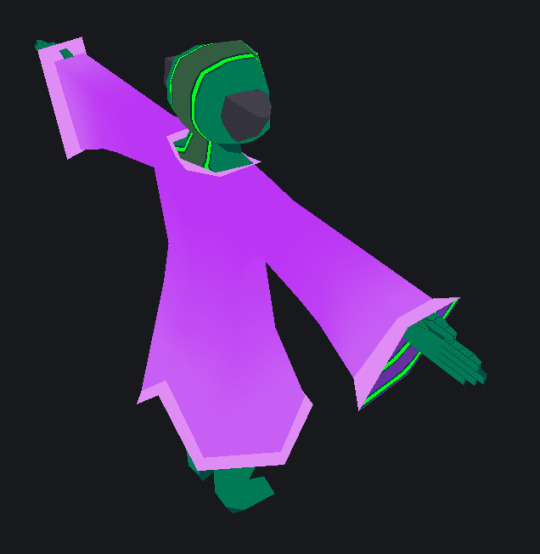
His antennae are pretty similar to how I did Sliver's, especially considering I did his first! XD They're separated from his head a bit.



Also if you've noticed in my art that his eyes are the exact same as in the model here, that's because they are! I tried finding a way to draw them how I usually might, but I just couldn't get the same vibe! So I said, "Fuck it!" and I've been drawing over his model ever since XD
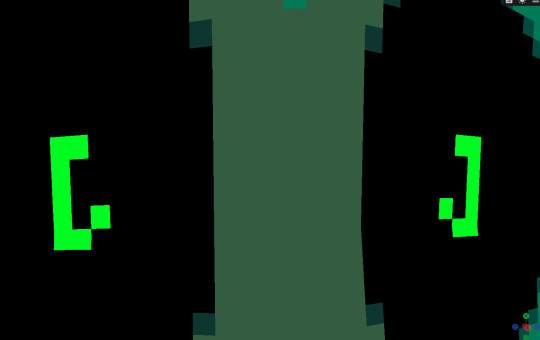
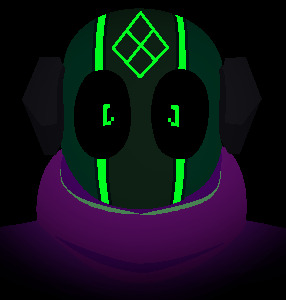
NSH is also who I used to make the "umbilical arm" model! So if you saw those posts, that's why the textures are all messed up!
And here it is in all it's glory!
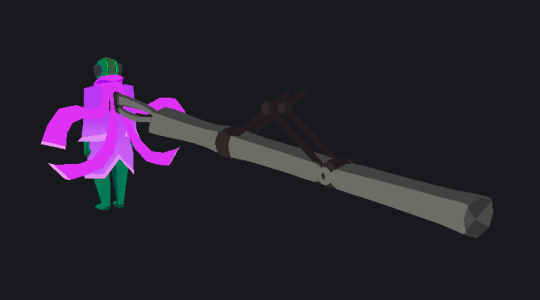
It's mostly made of ball joints with a flexible joint attached to the back. The last segment also twists just like your forearm bones!
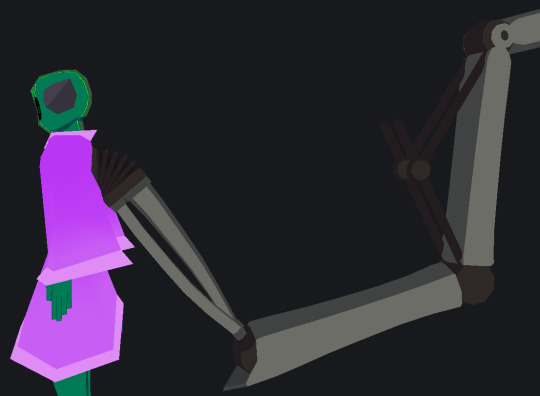
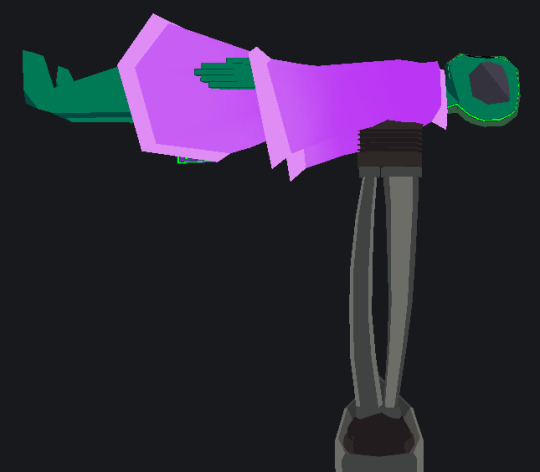

Also..... lore shit below cause I have, plans™ so-
If you don't want to know why NSH is acting strange on my blog yet, read no further!
(there's also some downpour spoilers, and some other disturbing things)
*slaps top of can* This bad boy can fit so much fucking insanity in him. (cw: self-harm yeah you heard me)
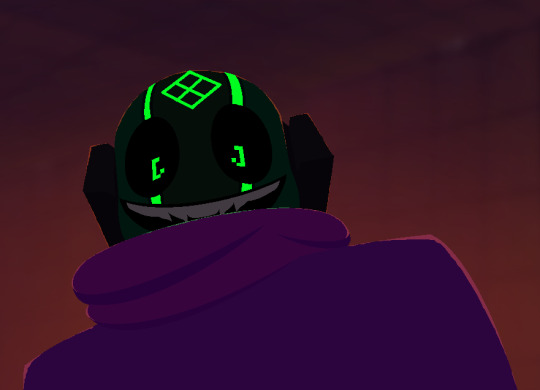
If you haven't figured it out already (I did drop hints :) NSH's structure is damaged! His legs are giving out because a group of scavengers thought it would be funny to transport all of their explosives at once.
So he's in a bit of a pickle!
This is when Looks to the Moon and Five Pebbles' communication tower is repaired! During their first conversation in a very long time, NSH finds out about good ol' Hunter long legs, and is rightfully distraught! He feels like a total failure, that he wasn't experienced enough to properly create his messenger.
That's what this whole post was about!
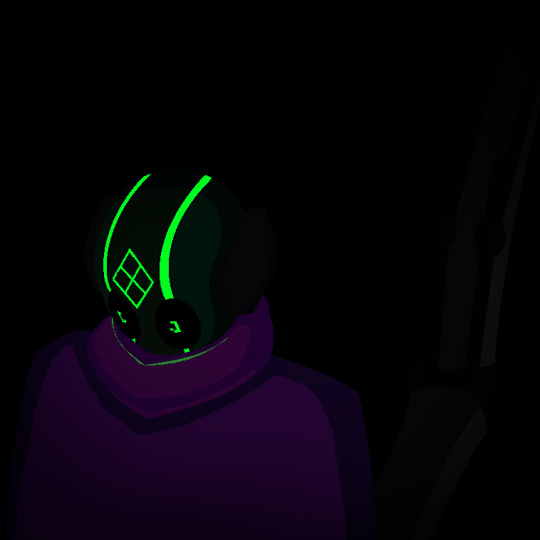
But, experience is something that can be gained.
NSH figured if Five Pebbles was able to leave his can, then he should be able to as well, but that requires solving the three problems I mentioned in the Five Rotten Pebbles post:
The self-genome modification barrier,
A general lack of puppet central brain matter, and
No material processing within the puppet.
I'll talk about my umbilical lore for this AU here since it's relevant.
Either the "cord" or the "arm" can be disconnected, but not both. This is for ease of repair by administrators. Disconnecting them both would leave the unfortunate Iterator fully functional. Although, they would be blind in the visible spectrum (apart from overseers), unable to speak directly to someone in their chamber, and would otherwise have their workflow be severely impaired. They would effectively be trapped in their own head.
NSH realised that even if the barriers existed, they could still have the intentions, to break them. So what would happen, if he broke one? Not by writing it out of his system, Five Pebbles already proved how risky that method was, but instead by setting his actions in motion faster than any barrier could stop them? This was something to test, and wasn't that what Iterators were built to do anyway?
Umbilicals can only be disconnected by administrators, but what if he were to do it anyway? He needed to leave his can after all, it wouldn't be much of a loss if he was stuck on the floor of his chamber or floating aimlessly in zero gravity for a while.....
So what if he just ran fast enough to rip himself off?
What if he moved his arm back at the last second, could he gain enough inertia to pull it out of his back? Even if it took a few tries?
What other choices does he have? Perfect Five Pebbles' method until he collapses and continue even then? He had time, but not enough for that, and The Hunter certainly did not have any time for waiting around. NSH had to fix his mistake, he had to.
So this bastard goes and does exactly that, and short-circuits his entire system.
Not just breaking the umbilical maintenance barrier, but every other one in the process.
And it all hurts like hell.
But that's the first problem solved, and now he can help keep himself afloat longer. So that now, he can figure out how to solve the other two problems with precision.
Of course, the others won't like any of these plans, but, after what Five Pebbles did, they wouldn't dare disturb him if he stopped responding, right?
And maybe, he could even hijack their communications array, to look for help.
>:]
yeah so NSH is not sane
#No Significant Harassment#rain world#rw no significant harassment#rw nsh#low poly#3d model#blockbench#Digi's RW Design Posts#downpour spoilers#generally fucked up mentally unstable rain world nonsense under the cut. It's marked at the top when you click read more#long post#very long post
41 notes
·
View notes
Text



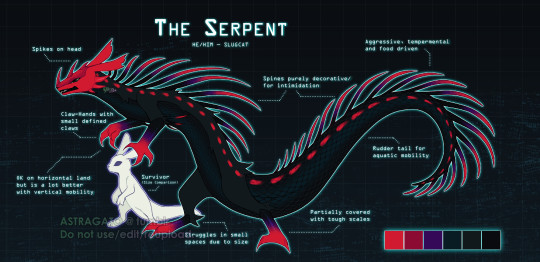
In contrast to my last two Rain World OC posts, these guys aren't one offs and are part of my current core OC group. More info about them under the cut since it's lengthy.
First starting with The Serpent —
The Serpent is one of AV's many bio-engineered slugcats - if you can even call him a slugcat at this point - as part of a simple passion of experimenting with flexible slugcat biology
They share several traits in common with red lizards, those being constant hyper-aggression, tremendous strength, projectile spit and size
As for similarities with slugcats, well, a general elongated shape? Oh, mobility, unlike red lizards, the Serpent is very adept with vertical movement
AV didn't really have a clear goal in mind with the Serpent unlike the rest of their tube babies, they just sort of... happened.
The spontaneity of their creation though has been very interesting as despite initially being created with the solitary lifestyle of a red lizard, the Serpent still keeps his slugcat instinct of adopting random children they find
Though the Serpent seems at first, displeased with this development but rest assured that if you ever LOOK at his pup wrong they will kill everyone in the room and then himself
Though not pictured in his reference since he was my first Rain World OC, created with very little knowledge of the lore and started as a one-off, he has a citizen ID drone which AV uses to keep track of him
He was also simply created out of my desire to have a long slugcat and my obsession with red lizards combined so there's that, too
Speaking of AV, moving on to Administrative Violence —
Named after the song of the same name by Lauren Bousfield, you'd expect them to be - well - violent. They're not, at least not with those they commonly interact with
They are actually quite sweet with Blown Blooms, their partner, and Peach the slugcat
Weather conditions, all things considered, are pretty mild where they are but far, far off into the distance their partner Blown Blooms isn't so fortunate and natural erosion as well as other random unfortunate events unrelated to weather, has taken quite the toll on them
As a result and fearing for Blooms in every way possible but especially for their communication's inevitable severing and also Blooms being lonely all on their own, AV created a slugcat who resembles a strawberry lizard - a species of lizard Blooms is especially fond of
Peach was designed for protection and companionship first and foremost and an emergency messenger/relay secondly.
Outside of worrying for Blooms' condition and yearning & longing for close physical proximity to them the way creatures who aren't supermassive structures have the luxury of, AV spends most of their time studying their bio-engineered slugcats.
Each and every one of them is given a citizen ID drone for ease of tracking as well as general classifications
They couldn't give a shit about whatever problem the other iterators are working on - just these funny little slugcats
They take the occasional interest in other animals too but it's mainly slugcats
And finally, Blown Blooms and Peach —
Blooms, like AV, is named after a song of the same name by Lauren Bousfield. Peach is just named after her colors.
Blooms, like their partner AV, has a complete disinterest in the great problem and a very big interest in bio-engineering
This time with plants rather than animals though they have a soft spot for small critters but they're usually never the subject of any experiments - just study and admiration
However, due to a deteriorating state, Blooms isn't quite able to use their equipment to manipulate genetic information like they used to - which is upsetting
So instead, they help AV with their current studies as well as keeping tabs on their own prior experiments
They have Peach now, though, which brings a much appreciated break from constant studying and nice close companionship
Peach will often catch prey outside and come back to eat it with Blooms and occasionally Blooms will play around with Peach and levitate the prey around for Peach to chase in anti-grav
The event that pushed AV to create Peach was when a creature entered Blooms' chamber and attacked them, partially damaging their puppet before being killed and then expelled from the chamber
Blooms is absolutely still capable of themselves and ultimately damaging the puppet a bit is nothing when taking account the sheer scale of an iterator - but AV will be AV
Plus, Blooms isn't complaining about getting a cute little companion from AV
And general trivia/info —
Everyone here is aroace. All of them. AV & Blooms' relationship is non-romantic in a sapphic way
The Serpent's pup's name is Pipsqueak
I know rudder tails shouldn't curve like that but I decided that after I finished drawing the Serpent and I wasn't about to redraw anything at that point
The other Iterators in AV and Bloom's local group are Illuminated Crown of Fire, Projections of Watchful Eyes, and an unnamed lunar-eclipse inspired iterator.
I have little information on them right now, but they are each based off of solar eclipses, stars and lunar eclipses respectively
In all, this local group is just a bunch of experiment freaks to varying degrees except for ICoF whose presence is often forgotten because of how little they speak but is also ever looming
And that's all! Thank you for reading this far in <3
#my art#my ocs#fanart#rain world#oc tag: the serpent#oc tag: administrative violence#oc tag: blown blooms#oc tag: peach#THE READ MORE IS VERY LONG i have Thoughts about my little weirdos#i have a whole iterator log between AV & blooms written out that i really want to draw something for but idk if i'll get to that#sure iterators off their string is cool but im obsessed w the fact that they're supermassive structures that cannot move from where they ar#yet feel so deeply and can create deep meaningful relationships with one another#i can only dream of articulating and capturing The Longing AV feels to be close to Blooms physically#it's there just trust me it's just stuck in my brain and i'll never be able to translate it out of my brain but just trust me on this one o#av looks at slugcat colonies and wishes that they could live with their local group in close proximity like that#blooms longs and yearns too but not as much as AV their mind is more preoccupied with their inevitable collapse and ruin
30 notes
·
View notes
Text
DLC in RPGs Poll
Since my previous poll was so much fun, I decided I'd put out another one!
How many of you have had the pleasure of booting up a game years after its original launch and getting overwhelmed with a bunch of prompts to start DLC that your low-level character is in no way ready for? Or come back to a game with newly-released DLC that you have to reload an old save prior to the endgame to complete? And how many times have you had to google "[Game title] when to do DLC?"
DLC in RPGs tend to occupy a strange space. These are games which, at their base level, are attempting to tell a complete story through their original runtime. So how do you go about expanding on that story without detracting from the original work? What, in your opinion, is the most effective way to introduce DLC?
**Please note, in this case I am referring specifically to "story" DLC: Major expansions that provide several hours' worth of playtime, as opposed to minor downloadable add-ons.**
[Examples and propoganda below]
Must be played before endgame: a.k.a. the Obsidian way. Here, DLC is either given early on, or gated gradually behind levels as the player progresses, but in either case, must be completed before finishing the base game. Pros - if you want your base game's story to drastically alter world events, this is the way to go. Cons - can greatly disrupt the flow of the base game's story and cause the overall experience to drag.
Playable anytime, pre or post-endgame: The most flexible option, usually giving the player a prompt to start the DLC at some point in the base game and then letting them complete it up into the endgame. Pros - the most freedom is given to the player here. Cons - this is the only option which requires the game to have a playable endgame state, which may not always gel with the story and requires more resources to develop.
Playable post-endgame only: This usually comes in the form of a DLC that extends the main story, or leads into the next instalment of the franchise. Pros - No need to worry about disrupting the main story's flow, or establishing an endgame state, since you can launch directly into the DLC. Cons - greatest likelihood that players will complain about the game's "real" ending being paywalled, plus you risk undermining the ending of the main story.
No major DLC: These games usually focus on improving the base game with small additions and patches over time. Pros - no need to worry about any of the above problems. Cons - there are no chances to further expand or iterate upon elements of the base game, plus the game might not have as much longevity.
Any other thoughts or methods I may have missed, please let me know in the tags!
#polls#my polls#game design#rpgs#crpg#video games#dragon age#witcher#witcher 3#pillars of eternity#divinity: original sin#fallout#fallout new vegas#skyrim#the elder scrolls#rpg polls
18 notes
·
View notes
Note
I honestly find it really damn funny to think of a/b/o dynamics because my brain skips the whole sex thing and jumps to world building instead - the iterators must have had that built into them, right? Bio super computers that the Ancients must have had a design in mind - would the Ancients think an iterator being an alpha would make their processing of the Great Problem focused? An omega flexible in experiments and variables? A beta trying alternate paths and multitudes of simulations?
Were there groups of Ancients who sided on how to build iterators in this fashion? Was there political unrest because of that?
Or were the iterators "born" with these aspects? Something to do with the material they are made from, how they were built, who took charge of their programming? Did groups of Ancients move off iterators to other iterators due to beliefs in the labels of alpha/beta/omega? Did this effect who was in charge, who was higher up in a Council, what was written on pearls and kept in the memory crypts - did it effect the iterators points of view, do groups of iterators after the Ascension discuss the Great Problem through the lens of their a/b/o status?
Was the dissatisfaction with Five Pebbles being built next to Looks To The Moon also heightened by Ancient society appraising Moon's alpha status as superior to Five Pebbles beta? Or that to build another next to her to "support" her deem her weaker in her status?
Would that have affected how she thought of Pebbles, made her more protective of him, more willing to give him leeway? Why she did not interfere sooner when her water supply was being leeched away, why she let things go too far for her to ever recover from?
Did Pebbles feel lesser compared to Moon when he first awoke and learned his place as an iterator? Did having that label on him and Moon make him subconsciously believe Moon would be fine no matter what he did?
Did making her fall make some small, shameful little part of him feel glee at having bested an alpha?
pt 1
11 notes
·
View notes
Text
Business Development in a Competitive Market: Strategies to Stay Ahead

In today's dynamic business landscape, thriving amidst fierce competition necessitates a strategic roadmap fueled by innovation, strategic thinking, and decisive action. This comprehensive guide serves as your compass, unveiling an array of meticulously tailored strategies designed not just to help you navigate the complexities but also to position your business as a torchbearer in a competitive market.
DOWNLOAD THE INFOGRAPHIC HERE
1. Understand Your Unique Value Proposition
In a world brimming with choices, establishing a distinct identity is paramount. This section delves into the intricacies of B2B Database Leads and B2B Lead Generation, unraveling the process of crafting a Unique Value Proposition (UVP) that resonates. By pinpointing your unique strengths and communicating them effectively, you forge a connection with your target audience that goes beyond transactional engagement.
2. Leverage Data Analysis
In an era where data is the cornerstone of decision-making, interpreting insights is a competitive advantage. Exploring Sales Leads and B2B Sales trends, this segment underscores the power of data analysis. By deciphering patterns, uncovering market shifts, and discerning consumer behaviors, you empower your business with the foresight needed to pivot proactively and capture emerging opportunities.
3. Prioritize Customer Satisfaction
Loyalty isn't just earned; it's cultivated through exceptional experiences. This part immerses you in the world of Sales Prospecting and B2B Database Leads, emphasizing the role of customer satisfaction. By anticipating needs, delivering prompt resolutions, and personalizing interactions, you foster a base of loyal customers who not only return but also advocate for your brand.
4. Invest in Technology
Technology isn't an accessory; it's the engine driving modern business. This chapter, interweaving Business Development and Sales Funnel strategies, magnifies the impact of technology investments. From streamlining operations to enhancing customer engagement, technological innovation is the catalyst for improved efficiency, customer delight, and strategic growth.
5. Engage in Strategic Partnerships
Collaboration isn't just a concept; it's a gateway to exponential progress. Venturing into B2B Lead Generation and AccountSend strategies, this section illuminates the art of forming strategic partnerships. By aligning with entities that complement your strengths and expand your reach, you embark on a journey of shared growth, propelling each other toward collective success.
6. Nurture a Strong Company Culture
Company culture isn't just for the office; it extends to every customer interaction. This segment dives into the subtleties of Sales Prospecting and B2B Database Leads, highlighting the significance of a robust company culture. A culture that champions innovation, values diversity, and empowers employees becomes the secret ingredient to attracting top talent and fostering exceptional customer experiences.
youtube
7. Adopt Agile Business Practices
Agility isn't just a buzzword; it's a competitive necessity. This part immerses you in the core of Business Development and B2B Sales, emphasizing the power of adaptability. By embracing flexible strategies, swift course corrections, and rapid responses to market shifts, you ensure your business remains poised to seize opportunities, even in the face of uncertainty.
8. Innovate Constantly
Innovation isn't sporadic; it's a perpetual journey. Navigating Sales Funnel dynamics and B2B Sales strategies, this section spotlights the importance of ongoing innovation. Whether through breakthrough products, iterative improvements, or ingenious solutions to challenges, a commitment to innovation becomes the lifeblood of your brand's growth and resilience.
9. Enhance Your Online Presence
In the digital realm, your online presence is your storefront. This part delves into Sales Prospecting and B2B Database Leads, emphasizing the role of a robust online presence. From an engaging website to active social media engagement, your digital footprint becomes the canvas on which you engage, educate, and forge connections with your audience.
10. Invest in Continuous Learning and Development
In a landscape where change is constant, learning is your compass. This final chapter, rooted in Business Development and Sales Leads, underscores the value of continuous growth. By fostering a culture of learning, you equip yourself and your team with the tools needed to decipher trends, refine strategies, and navigate the evolving landscape with confidence.
In the intricate tapestry of business, thriving is more than an aspiration; it's a science that marries B2B Lead Generation, Sales Prospecting, and Business Development. This guide empowers you to take the reins, lead with insight, and emerge as a frontrunner in the competitive race, armed with strategic prowess, innovative spirit, and an unwavering commitment to progress.
#AccountSend#B2BLeadGeneration#B2B#LeadGeneration#B2BSales#SalesLeads#B2BDatabases#BusinessDevelopment#SalesFunnel#SalesProspecting#BusinessOwner#Youtube
16 notes
·
View notes
Text
Koushiro Izumi Week 2023 Prompts
Koushiro week aims to offer flexibility and a variety of prompts, so that fans with different talents and amounts of free time can participate! This year, Koushiro and Tentomon took care to include folks who prefer to chat about their fandom experience or write short essays, as well as explicitly welcoming fans of Izzy <3

Entrants are free to select among the prompts on any day, or treat every day as a free day! You can post as many or as few times as you choose.
There is only one day with a set theme. Saturday October 14th will be Reblog Day! Entrants are encouraged to reblog their Koushiro and Tentomon content on that day, but please only reblog items that are not already on the Koushiro Week archive. I will make a special post on reblog day honoring our beautiful archive! Let’s share the Koushiro and Tentomon love, even if we are busy!
Event tag: izumikoushiroweek2023
Please find the prompts beneath the cut!
New Prompts for 2023
Crest of Knowledge What does the crest of knowledge mean to you? What do you think it means to Koushiro and Tentomon? How about the people who love them?
It's lonely at the top What is it like to be an outlier? Over the course of Adventure, Koushiro learns to use his gift to connect to others, rather than as a means to cope with lack of connection. This is beautiful, but still, being an outlier has to… complicate things. Do you think classmates or coworkers resent him and his success? Koushiro launches a business after high school. What is it like to have people relying on him for their livelihoods at such a young age? Do his older employees balk at having someone so young above them? Does he feel that he's missing out on higher education and fun college activities?
What are your Koushiro headcanons?
Alternate Universe Do you have any AU Koushiro designs? Alternate haircuts? Show us your wildest Koushiro dreams, from mermaids to crossovers to epic fantasy!
Koushiro the mentor
Koushiro often takes on the role of mentor. He's a member of both the Adventure and the 02 teams and works hard to support everyone. Show us Koushiro offering support to the Chosen: younger, older, or both! Explore his unique role and what it means to him. Does he enjoy sharing knowledge? Does he want to remain as involved as possible with the Digital World, even when the 02 crew takes over? So many Koushiros!
What is your favorite iteration of Koushiro? Adventure, 02, Tri, Kizuna, the reboot, the movies? Izzy and the various Koushiro dub iterations?
What is your favorite canon Koushiro outfit?
Show us a screenshot or draw it!
What is your favorite Koushiro or Izzy quote? How about Tentomon?
Screenshots/illustrations are encouraged, but not required.
Koushiro and Tentomon Screencap redraw
Koushiro memes!
Koushiro is Extremely Online, the boy has seen a meme in his day. Invent a Koushiro meme, or place him in an existing one! What memes do you think Koushiro would like?
Do you relate to Koushiro?
How so? Alternatively, what do you love about him and Tentomon?
What is something you wish we saw happen for Koushiro in canon?
I know we all have wish lists! Share yours!
Koushiro interacting with his parents I cannot get enough of the Izumis!
Prodigious!
What is your favorite prodigious moment? What do you love about Izzy? What are your thoughts about Koushiro vs Izzy?
Emotion As Koushiro grows more confident, perhaps he begins expressing his feelings more. Does he see this as a good thing (growth, trust that he is allowed to show how he feels), or regression (why can't I control myself like I used to)? How does Koushiro feel about personal expression and his emotions?
2022 Prompts
Feel free to use prompts from last year, or to re-interpret and explore ones you already used!
Koushiro and Tentomon
Wanna try your take on the classic Koushiro and Tentomon hug in the trolley? Or show us the boys being adorable, living their best lives together? The Koushiro and Tentomon relationship is so sweet, there is so much to explore here!
Adoption/family
Koushiro tells his friends about the adoption, visits the graves of his biological parents, meets his first ever biological relative when he has his daughter, spends time with his parents, etc. Also, Tentomon absolutely sobbing when he meets Koushiro’s kids, lol!
Friends/life outside of the Chosen
We don’t see much of Koushiro’s personal life throughout the Adventure content. What does this boy get up to? Who are his friends, both local and spread over the world? What are his hobbies? We know Koushiro is an incredible researcher/tech expert, but he is also a normal kiddo.
Confidence/the Chosen love you for you/everyone loves Koushiro
Koushiro struggles with self worth and confidence over Adventure. We see him find his way as the Digimon Tech Expert, but we know he’s so much more than that! Let’s explore Koushiro realizing that he’s needed and valued beyond his skills, and that he doesn’t need to be helpful to connect to and be loved by others- and that he very much is loved.
Confiding
Koushiro doesn’t discuss his personal life onscreen during Adventure, except to Tentomon and his parents. It would be amazing to explore him confiding in his friends.
Casual
Koushiro tries to speak more casually to his friends- this is inspired by this post.
Koushiro as the head of Chosen information/Koushiro’s company
What does Koushiro get up to in his company in Kizuna? How is he funding global Chosen activity and also researching and also having a life? How does he juggle everything? Does everyone look up to the guy who is making sure the global Chosen have the resources and information they need to operate? Are his friends concerned?
Plz help
Koushiro needs help, and the others rise up- whether he asks them to or not, lol! Maybe he’s stressed by work, juggling too much, or just in a research vortex and hasn’t come up for air in a while. Maybe a Chosen convinces him to lean on them and take a break. Or maybe someone pushes him to do “something fun,” and shenanigans ensue! Maybe Tentomon secretly calls the Chosen when Koushiro enters a Work Vortex or seems down.
Oolong tea
A classic, lol!
FASHUN
Koushiro explores fashion and style! Show us your best Koushiro Disaster Kouture ™, or show him growing out of that stage and settling into what you imagine his style might become. Does all the screen time result in glasses someday?
Eyebrows
Show us a range of Koushiro facial expressions! Dem brows are there for a reason >:3
Assistant Tentomon
Tentomon the mighty, making sure Koushiro remembers to Human (eat, sleep, call friends, etc). Tentomon, acting as Koushiro’s secretary/assistant. Tentomon learning how to research on his own! Tentomon sending an SOS when Koushiro needs some help, but is too polite to reach out.
Mochimon
HIM CUTE! HIM ROUND! SHOW US HIM!
Koushiro and Bugs
Koushiro sipping from a ladybug mug, Koushiro being gifted ladybug items, Koushiro finding ladybugs or beetles and thinking of Tentomon, Koushiro taking a bug outside when someone else wants to squish it, Koushiro casually revealing that he has an encyclopedic knowledge of beetles for Reasons.
Computer Club President Koushiro
Koushiro was the computer club president in 02 (hopefully this is true of both the English dub and original Japanese)! That would be so cute to explore!
Koushiro Playing Violin
Inspired by this.
18 notes
·
View notes
Note
I'm going to be asking a lot of artists I follow this question, but how did you develop your style? It SEEMS like most people find their style and stick with it forever, just making improvements and iterations. I tend to work in a lot of different styles because I enjoy doing that, though I know there are things I gravitate towards as well. But I wonder what your journey was and how you got feedback and improved while staying true to what you enjoyed?
What a good question, thanks for asking!
I guess the simplest way of putting it is that, ever since I started drawing I've just emulated whatever art I really liked the looks of, and over time it coalesced into style/s. When I was a kid my main art interests were Pokemon, Lisa Frank, and Disney cartoons, and later, "sparkledog" furry art. So I spent a lot of time emulating that kind of art in a sort of, just-drawing-what-you-see kind of way.
In recent years I've gravitated back to those early influences/styles, in a more "conscious effort" way than before. A few years ago, I actually made a sort of journal in which I dissected artists' work that I loved as a kid, and broke down which parts I wanted to incorporate into my own style. I also did a lot of studies and practicing to try and train my hand and brain into the style I wanted.
It's kind of a mixed bag way of doing things, to be honest. Depending on who you are, you might enjoy it more or less. I enjoyed finally producing stuff that looked like the art I admired as a kid. But at the same time, too much emphasis of getting a certain look kinda broke my natural flow and could be paralyzing at times.
Compare that process to the kind of style I use on pieces like this:

That style evolved over years in a much more natural feeling way. It almost feels like using a different part of my brain, to be honest. There wasn't a lot of direct influences there, so I think it's a case of me tapping into a certain vibe that I want and the resulting style is firm yet flexible for each piece.
I've worked in more styles than just those, of course. And as far as feedback from others goes, I think the best thing I absorbed from art school was to -not- box yourself into one style. I experimented all the time in college, we were discouraged from leaning too hard on style, and SO much growth comes from that. Sometimes you gotta let the piece dictate the style that you use! So I don't think it's a bad thing that you work in a lot of different styles!
I think so long as you keep absorbing influences, analyzing them, and incorporating the parts you like into your work, your style/s will come through naturally.
3 notes
·
View notes
Text
A Masterclass from David Bowie: Bringing Your Music Brand to Life | Daniel Siegel Alonso

A musician's brand is as crucial as their talent in the ever-evolving music industry. Creating a compelling and cohesive brand can catapult an artist from obscurity to superstardom, providing a distinct identity that resonates with global audiences. One of the most iconic examples of successful music branding is David Bowie. His ability to craft a unique, multifaceted brand is a masterclass for any artist. Here, Daniel Siegel Alonso examines the Thin White Duke's approach via three essential branding components: naming, visual identity, and sonic style.
What's in a name?
The first step in establishing a memorable brand, music or otherwise, is choosing the right name. David Bowie understood this concept profoundly. Born David Robert Jones, he adopted the surname "Bowie" to avoid confusion with The Monkees' Davy Jones. His choice of "Bowie" was not random; it was inspired by the Bowie knife, symbolizing a razor-sharp, cutting edge—qualities that would later define his career.
Little did Davy Jones know that the Bowie name would become a brand in itself, a shorthand for creativity and continual rebranding. Selecting a memorable name that reflects their musical mission is crucial for up-and-coming musicians. A name should be unique yet simple enough to be easily remembered and searched by potential fans. It's also essential that the name is flexible, allowing for growth and evolution, much like Bowie's did throughout his career.
Formulating an indelible image
Siegel Alonso notes that a visual identity is another cornerstone of any successful brand. David Bowie excelled at this, continuously transforming his appearance to reflect his artistic eras. Bowie's visual identities were not just premeditated looks but integral parts of his storytelling style, from the celestial Ziggy Stardust to the grand Thin White Duke.
At its zenith, a musician's visual identity encompasses album artwork, stage costumes, music videos, and now, a strong social media presence. For Bowie, each visual iteration was meticulously crafted to align with the themes and messages of his music. This alignment between visual and sonic elements created a holistic and immersive experience for his audience.
Modern musicians should take a page from Bowie's playbook by developing a cohesive visual style that complements their music. Whether it's through consistent use of colors, symbols, or fashion, a distinctive visual identity helps to create a lasting impression. Collaborating with talented designers and photographers can also elevate an artist's visual brand to new heights.
Inventing a unique sound
The beating heart of any musical brand is the music itself. David Bowie's sonic style was as diverse as his iconic visual transformations. He effortlessly glided through genres, from glitter rock and American soul to electronica and avant-garde jazz, constantly pushing boundaries. Despite this diversity, there was an unmistakable Bowie essence to his music, characterized by innovative production, trademark tone, and a sense of drama.
For new artists, defining a unique sonic style is essential. This involves more than just the genre; it encompasses the artist's voice, instrumentation, production choices, and lyrical themes. An artist's sonic style should be recognizable and consistent yet flexible enough to evolve. Much like Bowie did, collaborating with different producers and musicians can infuse fresh perspectives and innovation into the music.
The merging of elements
David Bowie's brand success was not merely the result of excelling in isolated elements but rather the synergy between naming, visual identity, and sonic style. His ability to seamlessly incorporate these components created an influential, enduring brand that transcended cultural trends.
Siegel Alonso recommends emerging artists learn from this holistic approach. It's vital to ensure that all brand elements work in concert together. A well-chosen name sets the stage, a compelling visual identity seizes attention, and a unique sonic style engages your audience. Each element should reinforce the others, creating a cohesive and compelling narrative that defines the artist's brand.
Conclusion
Bringing a music brand to life is a multifaceted endeavor that requires careful consideration and creativity. Bowie's extraordinary career illustrates the power of a well-thought-out brand, showing how a distinctive name, a compelling visual identity, and a unique sonic style can create an enduring legacy. Daniel Siegel Alonso suggests aspiring artists turn to David Bowie as an oasis of inspiration, embracing the art of reinvention and the implication of a cohesive brand. By doing so, they can carve out their own space in their world and leave a lasting impact on their audience.
#music#music industry#songwriter#artists#new album#new music#songwriting#artist#musician#artists on tumblr#david bowie
3 notes
·
View notes
Text
Elevate Your Agile Skills with Scrum Master Certification at Strategisminc

In the rapidly evolving world of project management, staying ahead requires continuous learning and adaptability. One of the most effective ways to enhance your agile skills and boost your career prospects is by obtaining a Scrum Master Certification. At Strategisminc, we offer a comprehensive Scrum Master Certification program designed to elevate your expertise and set you apart in the competitive job market.
Scrum is a widely adopted agile framework that emphasizes iterative progress, collaboration, and flexibility. As a certified Scrum Master, you will be equipped to guide teams in applying Scrum principles and practices, ensuring that projects are delivered efficiently and effectively. Our program at Strategisminc is meticulously crafted to provide you with a deep understanding of Scrum methodologies and their practical applications.
The Scrum Master Certification program at Strategisminc is led by industry experts with extensive experience in agile project management. Our curriculum covers essential topics such as the Scrum framework, roles and responsibilities of a Scrum Master, sprint planning, backlog management, and facilitating agile ceremonies. Through interactive training sessions, real-world case studies, and hands-on exercises, you will gain the skills needed to lead agile teams with confidence.
Strategisminc's training program includes access to comprehensive study materials, practice exams, and personalized support from our seasoned instructors. We ensure that you are thoroughly prepared to pass the Scrum Master Certification exam and earn your credential. Additionally, our flexible learning options, including online and in-person classes, allow you to choose the format that best fits your schedule and learning style.
Earning a Scrum Master Certification from Strategisminc not only enhances your professional credibility but also opens up numerous career opportunities. Certified Scrum Masters are highly sought after by organizations looking to implement agile practices and improve project outcomes. This certification demonstrates your commitment to agile principles and your ability to drive successful project delivery.
Invest in your future with Scrum Master Certification at Strategisminc. Elevate your agile skills, gain a competitive edge, and become a leader in agile project management. Enroll today and take the first step towards transforming your career.
#ProjectManagement#strategisminc#ScrumMaster#AgileTraining#PMP#SalesforceCertification#LeadershipTraining#AgileCertification#SAFe#CareerDevelopment#ProfessionalGrowth#CertifiedScrumMaster#AdvancedScrumMaster#SalesforceTraining#AgileLeadership#PMPCertification#ScrumCertification#ProjectManagementProfessional#SAFeScrum#AgileTransformation#CRMTraining#ProfessionalCertification#LeadershipDevelopment#AgileMethodology#ScrumMasterTraining#SalesforceExpert
2 notes
·
View notes
Text
Setting and achieving goals: a blueprint for success
Setting goals is a fundamental aspect of personal and professional development. Whether you're aiming for career advancement, improved health, or personal growth, the process of defining and pursuing objectives is crucial for success. This article explores the art of goal setting and provides a practical guide on how to not only set meaningful goals but also effectively achieve them.

Clarity in goal definition
The first step in achieving any goal is to clearly define it. Ambiguous goals such as "get healthier" or "be more successful" lack specificity. Instead, articulate your goals with precision. For instance, replace "get healthier" with "exercise for 30 minutes five times a week" or "lose 10 pounds in three months." The more specific and measurable your goals, the easier it becomes to track progress.
SMART goals
Adhering to the SMART criteria ensures that your goals are Specific, Measurable, Achievable, Relevant, and Time-bound. This framework provides a structured approach, guiding you to set goals that are not only clear but also realistic and attainable. For example, "Read 20 pages of a book every day for the next month" is a SMART goal, as it specifies the activity, sets a measurable target, and defines a time frame.
Break down goals into manageable steps
Large goals can be overwhelming, leading to procrastination or abandonment. To counter this, break down your goals into smaller, manageable tasks. If your goal is to start a small business, break it down into steps such as market research, business plan development, and securing funding. This makes the overall objective more achievable and allows for a sense of accomplishment at each stage.
Prioritize and focus
Not all goals are created equal. Prioritize your goals based on their importance and impact on your life. Focus on a few key objectives rather than spreading yourself thin. This concentrated effort enhances the likelihood of success. Remember, quality over quantity is the key to effective goal setting.
Regularly review and adjust
Goals are not static; they evolve as circumstances change. Regularly review your progress, celebrate achievements, and assess any setbacks. Adjust your goals accordingly, taking into account new information and experiences. Flexibility in goal setting is essential for long-term success.
Stay motivated
Maintaining motivation is crucial for goal attainment. Identify the reasons behind your goals and use them as a source of inspiration. Whether it's personal growth, financial stability, or improved well-being, connecting emotionally to your objectives reinforces your commitment.
Seek support and accountability
Share your goals with others and seek support from friends, family, or mentors. Having someone to hold you accountable can significantly increase your chances of success. Regular check-ins with an accountability partner provide motivation and encouragement during challenging times.
Setting and achieving goals is a dynamic and iterative process. By following these guidelines, you can create a roadmap for success in various aspects of your life. Remember, the journey towards your goals is as important as the destination. Stay focused, stay motivated, and celebrate each milestone along the way. With a well-defined plan and dedication, you can turn your aspirations into tangible achievements.
8 notes
·
View notes
Text
How to Select the Best Cryptocurrency Development Services Provider Near You?

Choosing the right cryptocurrency development services provider is crucial for the success of your blockchain project. Whether you're launching a new cryptocurrency, developing a decentralized application (dApp), or planning an Initial Coin Offering (ICO), finding a reliable and competent development team can make all the difference. Here’s a comprehensive guide to help you navigate this important decision.
1. Define Your Project Requirements
Before you start looking for a cryptocurrency development services provider, it’s essential to clearly define your project requirements. Outline the scope of your project, including technical specifications, desired features, security considerations, and any regulatory compliance requirements. Understanding your project needs will help you evaluate potential providers more effectively.
2. Evaluate Technical Expertise
One of the most critical factors in selecting a cryptocurrency development services provider is their technical expertise. Look for a team that has a proven track record in blockchain development, particularly in the specific technologies and platforms you intend to use (e.g., Ethereum, Hyperledger, Stellar). Verify their experience through case studies, client testimonials, and their portfolio of completed projects.
3. Assess Security Measures
Security is paramount in the cryptocurrency and blockchain space due to the high value of digital assets and the prevalence of cyber threats. Ensure that the development services provider has robust security protocols in place, including adherence to best practices such as code audits, multi-layered encryption, secure smart contract development, and regular security updates.
4. Check Regulatory Compliance
Regulatory compliance is another critical consideration, especially if your project involves tokens or involves financial transactions. Ensure that the development team is well-versed in relevant regulatory frameworks (e.g., KYC/AML regulations) and can implement compliance measures effectively. A reputable provider should prioritize legal compliance to mitigate regulatory risks.
5. Evaluate Development Methodologies
Understand the development methodologies and processes employed by the cryptocurrency development services provider. Agile methodologies are often preferred in blockchain development for their flexibility and iterative approach. Ensure that the provider emphasizes transparency, regular communication, and milestone-based deliverables to keep your project on track.
6. Review Client Support and Maintenance
Post-launch support and maintenance are crucial for the long-term success of your blockchain project. Inquire about the provider’s support services, including troubleshooting, bug fixes, and updates. A reliable provider should offer ongoing maintenance to address evolving technological and security needs, ensuring the continued functionality and security of your platform.
7. Consider Industry Reputation and Reviews
Research the reputation of potential cryptocurrency development services providers within the industry. Seek reviews from past clients and industry experts to gauge their reliability, professionalism, and overall satisfaction with the services provided. Online platforms, forums, and social media can provide valuable insights into the provider’s reputation and client relationships.
8. Evaluate Cost and Budget
While cost shouldn’t be the sole determining factor, it’s important to consider your budget and compare pricing among different providers. Beware of overly low-cost offers that may compromise quality or lack transparency in pricing structure. Look for a provider that offers competitive pricing aligned with the scope and complexity of your project, with a clear breakdown of costs.
9. Assess Communication and Collaboration
Effective communication and collaboration are essential when working with a cryptocurrency development services provider. Evaluate their responsiveness, clarity in communication, and willingness to understand your project vision. A provider who values collaboration and offers proactive suggestions can contribute significantly to the success of your blockchain venture.
10. Seek Customization and Scalability
Every blockchain project is unique, requiring tailored solutions to meet specific objectives. Ensure that the development services provider offers customization options and scalability to accommodate future growth and evolving market demands. Whether you’re launching a startup or expanding an existing platform, scalability should be a key consideration in your provider selection.
Conclusion
Selecting the best cryptocurrency development services provider near you involves careful evaluation of technical expertise, security measures, regulatory compliance, support services, reputation, cost, and collaboration capabilities. By thoroughly assessing these factors and aligning them with your project requirements, you can make an informed decision that sets the foundation for a successful blockchain venture.
Choosing the right partner is not just about finding a development team but selecting a strategic ally committed to your project’s success from inception through implementation and beyond.
#Cryptocurrency Development Services#Cryptocurrency Development#Cryptocurrency#Crypto#Cryptocurrency Development Solutions#Cryptocurrency Development Company#Cryptocurrency Development Agency
2 notes
·
View notes
Text
Ruins introduction post
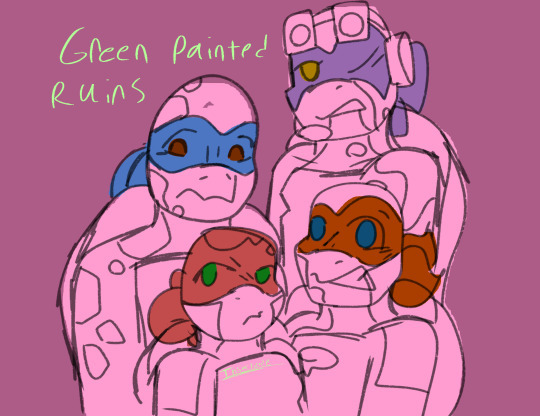
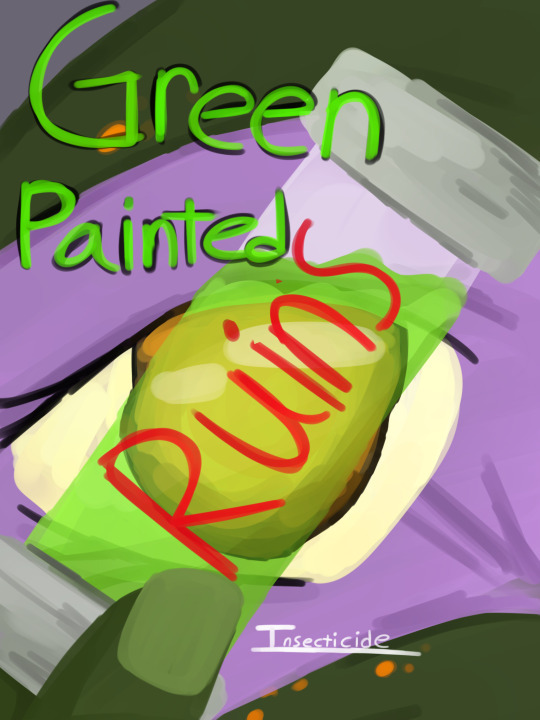
(Both drawings are old, I'll update them laterr)
Welcome to Ruins! Previously known as Green Painted Ruins, as you can see.
Tag: Green painted ruins au
I haven't updated the introductory post in a while!! Wow!! I have so many followers now that don't even know what Ruins is so y'know what better time to rewrite the entire introductory post?
Ruins was the first ever iteration I made for the TMNT fandom, and the second au I made overall. It was initially created as a weird mesh between the Bayverse tmnt films, rottmnt, and 2012 tmnt. As expected, I could not stick to that and it went wayy farther than it was supposed to go. I'm planning on picking up on posting about Ruins pretty soon! I haven't talked about them in a while (I think I haven't actually talked about them much since the iteration comps, which makes sense because I talked about them a *lot* during that time) and I think it's about time they start being seen again.
I'm not gonna include a 5 hour long rant like in the original post, so instead you're getting the basics about the au. :
The turtles were experiments and intentionally mutated. Not for the purpose of mutating animals or having turtle soldiers or anything like that. No, they were tests of mutagen.
Mutagen, which is essentially modified Kraang decomposition! Kinda gross, right? Well, there was a goal behind its creation. Dimension X, the home of the Kraang, has a weird ability that nothing there can truly die. Your body can die, your heart can stop, but your brain keeps running and as long as your limbs are still connected to your body your brain will keep piloting them. So why not try to harvest that ability? Why not try to give humans the ability to pilot themselves long after they should be in the ground?
Making animals that are formed like humans and that have the brain activity of humans is just one of the various tests that the Foot Clan have conducted to further mutagen experiments.
But when a few of their experiments escape they run into a bit of a problem..
Leo. The first mutated, oldest at 16. Olive Ridley Sea Turtle. Was the first test of retro-mutagen, a failsafe designed to reverse the effects of mutagen. They learned that once mutagen is in something's system it can never truly leave. Is a bit less human than the other turtles. Will get severely dehydrated if he's out of water for too long.
Dannie. Second mutated, second oldest at 15. North American Wood Turtle. Is the most similar to a human as far as appearance goes, but has more turtle-like instincts than the rest of them. If a turtle cannot digest something she cannot digest something.
Michael. Third mutated, tied for youngest at 13. Bog Turtle. Because of the more accidental nature of his mutation, he wasn't mutated as thoroughly. He is still ectothermic and isn't very good at regulating his body temperature. It's quite uncomfortable for him. He's often found clinging to Raphael because of this.
Raphael. Last mutated, tied for youngest at 13. Bog Turtle. Because of the more accidental nature of his mutation, he wasn't mutated as thoroughly. His bones are weird and he's significantly more flexible than the rest of them, able to fit into his shell rather easily. Also has terrible eyesight but refuses to wear glasses because the braces are bad enough, okay?
The experiments were conducted by the Foot Clan (led by Oroku Karai) with assistance from the O'Neil company.
For this iteration I have talked about
The Everything is Fine (it's not) arc The Foot Clan arc The Dimension X/Venus arc The Maybe Everything COULD be Fine arc The Everything is Fine (it is this time) arc
These are not the ONLY arcs, but they're the biggest ones
I was planning on making refs when I first made this introductory post but I never ended up getting past Michael and Raphael. So. Just take them at the beginning of the story (pre foot clan arc).

#tmnt#tmnt iteration#tmnt au#green painted ruins au#Wiks rants#au concepts#death mention#death tw#ask to tag#kinda gross
18 notes
·
View notes